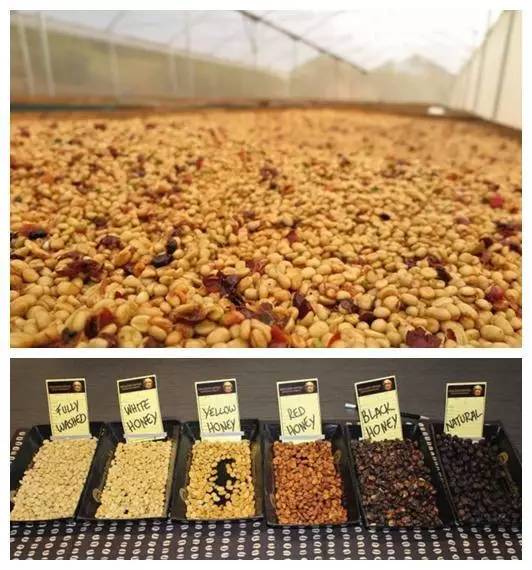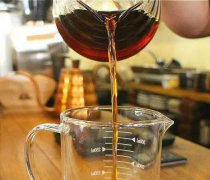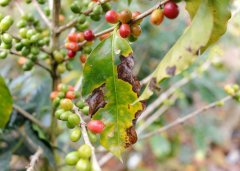The difference between single coffee and blend coffee The classification of single coffee beans Farm and other labels

For professional baristas, please follow the coffee workshop (Wechat official account cafe_style)
Classification system of coffee beans
A dazzling array of coffee names:
Single product, deep baking, city, Italian style, French style, special style? How is this divided?
What does it mean behind these complicated-looking coffee bean names?
1. Indication of origin: "single product" and "comprehensive" coffee
The coffee beans sold in the market can be roughly divided into two categories:
Single Coffee (Single Origins referred to as S.O)
Mixed coffee (Coffee)
"single coffee" generally refers to specific coffee from specific countries, producing areas and manors.
It's like a famous singer who plays solo on the stage.
Coffee grown in each country or region has its own characteristics in terms of climate, soil and natural environment.
By tasting "individual coffee", you can understand the characteristics and flavor of coffee in a country or region.
Identification method:
If a bag of coffee has the name of the coffee producing country marked with it
This is most likely a bag of individual coffee.
Example:
Papua New Guinea-Sigri (Papua New Guinea Sigri)
Ethiopia-Yegashev (Ethiopia Yirgacheffe),
Kenya AA Top (Kenya AA Top) … Wait.
"mixed coffee" refers to coffee beans mixed with several types of single coffee.
It's like a big glee club.
It is worth noting that European countries do not produce coffee beans.
If the coffee you buy is labeled with the names of Italy, Vienna and other European countries, it is mostly mixed coffee.
Example:
The strict selection of special beans: PNG selection, PNG amorous feelings, and PNG tipsy from Kwon Cafe' Jin Tan.
The blending method of integrated coffee can be very simple (such as the traditional "Mamba": Mantenin plus Brazil)
It can also be a profound art. Through the ripeness of each cup of coffee and the taste of the blender.
It can make the original unique coffee compose a more harmonious and wonderful movement.
The beans usually used in espresso (espresso, latte, cappuccino) are mixed coffee.
The characteristic is that the aroma and oil of the coffee are particularly strong, which complement each other with pull-flower milk foam.
The blending method of integrated coffee can be very simple (such as the traditional "Mamba": Mantenin plus Brazil)
two。 Marking of baking degree: deep baking, Nanyi, Beiyi, Vienna, French baking
In addition to the labeling related to the place of origin, the most common is the marking of baking degree. Raw coffee beans need to go through the baking process
In order to release the unique charming aroma, the roasting of coffee is closely related to its flavor.
If you see "Italy", "Vienna", "Nanyi" and other signs on the coffee label
Do not mistakenly think that a bag of coffee beans has anything to do with the above place names.
Because "Italy" and "Vienna" are just synonyms for the degree of baking
Doesn't mean it's coffee from Italy or Vienna.
(1) Light Roast: very shallow baking, also known as "shallow baking"
Time to drop beans: before and after the start of the explosion
Wind taste: the bean surface is light cinnamon color, with a strong smell of grass
The taste and aroma are not enough, so they are generally used for experiments and seldom for tasting.
(2) Cinnamon Roast: shallow baking, also known as cinnamon baking
Time to drop beans: an explosion begins to be dense.
Wind taste: the bean surface is cinnamon, and the smell of grass has been removed.
Strongly sour and slightly fragrant, it is often used to make American coffee.
(3) Medium Roast: medium baking, also known as "micro baking"
Time to drop beans: from the explosion to the end
Wind taste: the bean surface is chestnut color, the taste is light, sour and bitter, and the aroma is moderate
Retain the original flavor of coffee beans, often used as American coffee or mixed coffee.
(4) High Roast: moderate micro-deep baking, also known as "concentration baking"
Time to drop beans: the end of the first burst
Wind taste: the bean surface is light reddish brown, the taste is fresh and rich, sour and bitter balance is not irritating, and slightly sweet
The aroma and flavor are all good. Kenya AA, Yegashev and Blue Mountain Coffee are all suitable for this roasting degree and are loved by people in Japan and Central and Northern Europe.
(5) City Roast: medium-depth baking, also known as "urban baking"
The time to drop the beans: after the first burst, that is, between the first and second bursts.
Wind taste: the bean surface is light brown, the taste is bright and lively, the sour and bitter balance is light, releasing the high-quality flavor of the coffee.
The standard roasting degree, which is also the favorite roasting degree of the public (e.g. PNG AA and Banuax), is often used in French coffee.
(6) Full City Roast: micro-depth baking, namely deep baking, also known as "deep city baking"
Time to drop the beans: the second burst
Wind taste: the bean surface is brown, the taste is calm and full, the bitter taste is strong, the aftertaste is sweet, and the aroma is full.
For Central and South American roasting, make more iced coffee and black coffee.
(7) French Roast: very deep baking, also known as "French baking"
Time to drop beans: the second explosion is dense to the end of the second explosion.
Wind taste: the bean surface is dark brown with black, strong taste, strong bitter taste, light sour taste and almost no feeling.
With rich chocolate and micro-coke flavor, it is the most popular in Europe to make coffee Oulei and Viennese coffee.
(8) Italian Roast: extremely deep baking, also known as "semantic baking"
Time to drop the bean: the second explosion ends until the bean surface turns black and produces oil.
Wind taste: "Nanyi" bean surface is black and oily, coffee bean fiber before carbonation, taste strong complex, bitter, rich and smooth
With caramel-like sweet aftertaste, mainly popular in Latin countries and Italy, do more Italian coffee Espresso use.
"Beiyi" usually represents medium-light, light brown, unoiled roast beans, and coffee usually tastes a little sour.
(9) Melange: Milanji, a blend of coffee beans of different roasting degrees.
3. Classification, production areas, farms, and other marks of coffee beans
At present, the grading system of coffee bean producing areas in the world has not been unified, and each coffee producing country has its own grading system and grading name.
So you may see the following words "SHB", "AA", "Supremo", "Extra-Fancy", "G1 / G2" and so on on the coffee label.
These are professional names used to distinguish the grades of raw coffee beans.
Orthodox professional roasters must clearly mark the grading of each packet of coffee, or even the name of the manor or cooperative where the beans were born.
"Central America"
Coffee is graded according to planting altitude, and coffee beans above 4500 feet above sea level are marked "SHB" (extremely hard beans Strictly Hard).
"Kenya"
AA+ (AA Plus) is the highest grade of Kenyan coffee. Only batches with excellent flavor and few defects are allowed to be marked "AA+". AA is the largest particle, AB is smaller and PB is a round bean.
"Ethiopia."
G1.G2 is the most advanced water-washed bean G1.
G3.G4 is the sun bean G3 belongs to the most advanced sun bean.
There are five levels of raw coffee beans in Ethiopia.
Subject to 300 grams, the number of tolerable defective beans is:
Grade1 0Murray 3
Grade2 4muri 12
Grade3 13Murray 25
Grade4 26Murray 45
Grade5 46muri 90
Oceania
Papua New Guinea, for example, is judged by the number of defects per kilogram, while the tolerable number of the same defect ranges from 1 to 5.
(for example, 1 moldy bean is a defect, but other beans such as 5 damaged beans are a defect), the less the number of defects, the higher the grade.
Raw coffee beans in Papua New Guinea are divided into 9 grades, subject to 1000 grams (1 kg). The number of defective beans that can be tolerated are:
A = 10
PB = 10
X = 20
C = 25
PSC = 35
Y1 = 70
Y2 = 150
Y3 = 280
T = defects of not more than 30 (or 3%) per kilogram
"South America"
In Colombia, for example, coffee beans are graded according to their appearance size and defect rate, with "Supremo" indicating the largest particle.
It is worth noting that the appearance and size of coffee beans have nothing to do with their flavor. The higher the altitude of the producing area, the better the flavor.
The name of the country is immediately followed by the marking of small producing areas.
Take Ethiopia-Ethiopia Yirgacheffe as an example
Ethiopia Ethiopia is the name of the coffee producing country, saying it is a "single coffee".
Yegashev Yirgacheffe is a narrow and small producing area at high altitude in the Sidamo district of Ethiopia (Sidamo).
Different small producing areas mean different flavor characteristics:
For example, the famous Ethiopia-Haramoka (Ethiopian Harrar Mocha) is produced in southern Ethiopia near Somalia.
Haramoka has wine-like aroma, blueberry or grape flavor, thick taste
Yega snow coffee is fresh and bright, with citrus or lemon peel aromas and a clear taste.
However, some coffee beans have a list of names immediately after the name of a small producing area, which may be the name of a coffee farm, cooperative, or raw bean processing plant.
Such as Guatemala-Antigua-Los Mokens
(Guatemala Antigua)
This long list of names tells us the following information:
Producing country: Guatemala-Guatemala is a famous coffee producer in Central America.
Producing area: Antigua (Antigua)-this is the famous volcanic coffee producing area of the country.
Grading: extremely hard beans (SHB)-indicates that this coffee grows at an altitude of more than 4500 feet.
Production Manor: Finca Los Volcanes Manor-"Finca" is the Spanish word for "Estate", meaning farm.
Harvest year: 2011-year is a reference for bakers, so the year is usually not marked on the market baked bean label.
In the coffee beans sold in the market, in order to reduce the trouble and identification burden of consumers, they generally do not make such lengthy and complicated markings.
It usually simply indicates the country of production, the production manor (cooperative), the altitude of the producing area and the grade of raw beans.
There may be great differences in the flavor of coffee beans in different small producing areas and years.
Professional roasters will taste the coffee raw beans from each producing area every year, and adjust the way of roasting and blending, so that consumers can get products with stable flavor and little difference.
Important Notice :
前街咖啡 FrontStreet Coffee has moved to new addredd:
FrontStreet Coffee Address: 315,Donghua East Road,GuangZhou
Tel:020 38364473
- Prev

Why drink bitter and astringent coffee?
Exchange of professional baristas Please follow the Coffee Workshop (official Wechat account cafe_style). No matter how busy it is in 1996, I would like to have a cup of coffee with you. At that time, Nestle instant coffee gave us a reason to have leisure in our busy life. In 2011, the unified superstore invited actor Guilun magnesium to shoot a series of advertisements in my cafe, which made us more accustomed to following.
- Next

Differences and Flavor characteristics between single Bean and mixed Bean, must single Coffee be Fine Coffee
Communication between professional baristas Please follow the coffee shop (official Wechat account cafe_style) to buy coffee beans, the boss asked me whether I like single beans or mixed beans, what is the difference between the two? I have prepared single beans and mixed beans for you to distinguish, hence the name Si Yi, single bean is a single kind of beans produced in a region, not mixed with other beans, has its own special
Related
- Detailed explanation of Jadeite planting Land in Panamanian Jadeite Manor introduction to the grading system of Jadeite competitive bidding, Red bid, Green bid and Rose Summer
- Story of Coffee planting in Brenka region of Costa Rica Stonehenge Manor anaerobic heavy honey treatment of flavor mouth
- What's on the barrel of Blue Mountain Coffee beans?
- Can American coffee also pull flowers? How to use hot American style to pull out a good-looking pattern?
- Can you make a cold extract with coffee beans? What is the right proportion for cold-extracted coffee formula?
- Indonesian PWN Gold Mandrine Coffee Origin Features Flavor How to Chong? Mandolin coffee is American.
- A brief introduction to the flavor characteristics of Brazilian yellow bourbon coffee beans
- What is the effect of different water quality on the flavor of cold-extracted coffee? What kind of water is best for brewing coffee?
- Why do you think of Rose Summer whenever you mention Panamanian coffee?
- Introduction to the characteristics of authentic blue mountain coffee bean producing areas? What is the CIB Coffee Authority in Jamaica?

